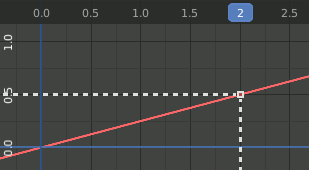简介¶
驱动器通过函数来控制属性值。
事实上,驱动器由以下部分组成:
驱动器配置 ,指定0个,1个或多个使用其他属性或物体变换通道的输入值,并使用预定义的数学函数或自定义的Python表达式将其结合在一起。
动画 函数曲线,将驱动配置的输出映射到最终值,以应用到被驱动属性。
例如,物体1的旋转可以被物体2的位置控制。可以说,物体2的位置驱动物体1旋转。
驱动器不仅可以调用大多数属性值,直接映射到其他属性,而且属性也可以作为数学表达式或者Python脚本的一部分,通过函数进一步调整。
驱动器是构建装备的极其强大的工具,通常用于驱动骨骼变换以及形状键,操作约束和影响修改器,通常使用自定义属性作为输入。
曲线视图¶

曲线编辑器中的驱动器范例。¶
如图 X轴 映射驱动器的控制变量。单位取决于驱动器。
而 Y轴 是被驱动的属性值。单位取决于物体属性。
在示例图中,如果控制变量为2.0,则被赋予的属性值为0.5。
The default F-curve is an identity map, i.e. the value produced by the driver configuration is applied to the driven property unchanged. If the driver output value is 2.0, the property will be 2.0.
The driver function can be defined artistically with Bézier curve handles or mathematically with trigonometric functions or polynomial expressions such as \(y = a + bx\). Furthermore, the function can also be procedurally modulated with noise or cyclic repetitions. See Modifiers for more details.